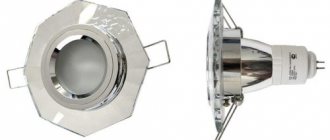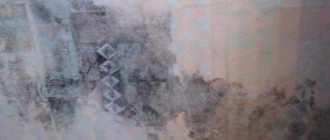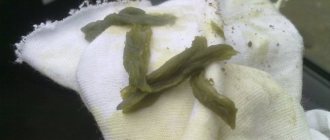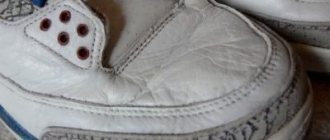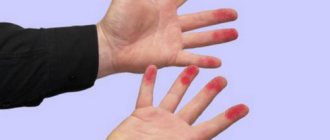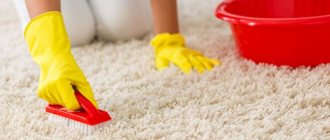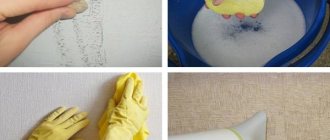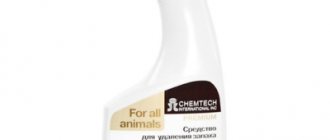Detergents for care
It is important to clean with soft sponges or cloths so as not to damage the film. In addition, the means used to clean the surface play an important role. Professionals recommend using special compounds for stretch film that are designed for this purpose; thanks to them, you can cope with severe contamination. They will be able to remove soot, suspended ceiling adhesive and even paint.
Cleaning products and accessories
Attention! Do not use liquids that contain acetone. It can damage or even corrode PVC film.
Liquids that contain alcohol help clean the ceiling quickly and easily. After the contaminated areas have been cleaned, wipe the entire surface with a dry microfiber cloth. This will eliminate stains and provide a pleasant shine to the ceiling. Microfiber is a modern cloth that perfectly absorbs moisture and does not leave lint.
Preparation
During operation, a fairly large amount of dust is generated. Therefore, we recommend that you immediately remove all carpets from the room, otherwise further cleaning them will take a lot of time and effort. All upholstered furniture should also be removed.
First you need to prepare the room
It is better to curtain the cabinets with oilcloth and lay it on the tables. Only after all the furniture is protected from the possibility of dust contamination can the work process begin. Additionally, open doors and windows to create a draft to remove suspended particles along with the air.
Before starting treatment, moisten the ceiling generously with water. This will reduce the amount of dust released and make its structure heavier, soaking the glue. The removed layer from the ceiling will settle faster on the floor, and you will need to do a thorough cleaning after work. It is impossible to saturate the ceiling with water at one time, so you will need to repeat the procedure at short intervals.
Recommendations for cleaning
The tension surface must be monitored regularly so as not to accumulate dust or other contaminants, which are then much more difficult to deal with. Timely cleaning is a guarantee of long service life of the material. Wet cleaning is not always necessary; you can use dry cleaning with a vacuum cleaner. When vacuuming, it is important not to touch the surface with the nozzle so as not to touch or damage it.
When using detergents when cleaning (soap, powder), use warm water with a temperature of no more than 40 °C. If the ceiling is glossy, use alcohol solutions for cleaning; even the products used to clean windows will do. But heavily contaminated surfaces are cleaned using products specially designed for this purpose.
When purchasing stretch ceiling care products, take into account the type of stains formed, the material (film or fabric) and the texture of the coating (glossy or matte).
The soap solution is suitable for any type of fabric. With this product, prepared at home, cleaning is carried out once a year so as not to accumulate a lot of dust or other contaminants.
How to remove stains from a fabric ceiling
This type of coating is more difficult to maintain because it gets dirty faster and is difficult to clean compared to PVC films. Therefore, it is better to remove stains while they are fresh and dirt has not penetrated between the fibers.
Clean the fabric trim using a mild soap solution. To do this, use a damp, well-wrung out microfiber cloth. If you wet the coating too much, it will take a long time to dry.
Severe contamination is eliminated with soda ash with a small amount of table salt or fatty clay. The components are mixed, diluted with water to a mushy state, applied, and allowed to dry. Then wash off the cleaner.
Difficult stains that cannot be removed are not a death sentence. Fabric ceilings are allowed to be repainted. Therefore, unsightly stains and other similar defects are simply hidden under a layer of paint.
Subtleties of cleansing
The main task of caring for a mirrored ceiling is to maintain its characteristic shine. If you use the products incorrectly or do the cleaning itself, it will disappear. Treating the ceiling with a 10% ammonia solution will return the former shine. A few minutes after applying it, wipe the surface dry with a soft cloth. Special polishes will also help restore shine.
Cleaning glossy fabric
The matte surface is easier to clean. It is enough to wash it with soapy water. Ammonia is also useful in the kitchen.
A fabric surface is more difficult to clean. In this case, you will have to use a brush with very soft, delicate bristles, and use a soap solution to remove stains. Before using any detergent, apply it to a small, inconspicuous area, and check the result after half an hour to make sure everything is fine.
Special contaminants
During finishing, various compositions and means are used. For example, paints, glue or polymers, which turn into a durable film after being applied to the surface and drying. Removing such contaminants is not so easy.
Water-based paint is easy to clean; it dissolves well in water. You just need to wet the area with water several times, wait until the paint softens and comes off the film. If it is an old mark, very carefully treat the surface with white spirit, and then carefully remove the residue.
Traces of construction adhesive are washed with a glass cleaner or white spirit, and then be sure to wipe dry with a rag. Removing a stain from a primer is an impossible task. A deeply penetrating agent cannot be eliminated at home. In this case, it is best to contact specialists or the manufacturer of this material for help.
Dry and wet cleaning method
The dry method involves using a brush or vacuum cleaner if the material is fabric. The film surface cannot be cleaned with a brush. The vacuum cleaner nozzle should not touch the ceiling, as it can deform the film.
Using a vacuum cleaner with a special attachment
Wet cleaning takes longer, as everything will have to be done manually. They wash the ceiling while standing on a stepladder.
To prepare a washing solution, dissolve a small amount of liquid or laundry soap in warm water (grit it first); washing powder is also suitable, but only without bleach. Products containing chlorine lead to loss of color of the fabric. The contents are stirred, microfiber or a prepared sponge is moistened in it, squeezed out and the surface is cleaned, performing circular movements.
The pressure on the film should not be too strong so as not to damage it. The fabric sheet is cleaned in the same way, but more pressure can be applied to it if you need to remove the glue stain in order to wipe the area well. When cleaning a fabric surface, the sponge is wrung out harder, since the material is afraid of moisture and dries more slowly than film.
Glue on a suspended ceiling: how to remove it and how to do it correctly
The greater the desire to install the vinyl sheet without a single spot, the greater the likelihood that you will have to look for a way to remove the glue from the stretch ceiling after the work is completed. Even experienced craftsmen leave offensive stains, so there’s nothing wrong with that. You just need to have an effective and at the same time safe means on hand to remove accidental glue residues.
Even transparent glue can cause a lot of problems
Features of glue stains on a stretch ceiling
The problem of eliminating traces of fabric gluing is not to remove dirt. It is important to do the cleaning as carefully as possible so that you do not end up having to completely change the stretch ceiling or mask the stains with decor.
In fact, the surface of the decorative cladding consists of two layers:
- Vinyl or PVC plastic is the basis of a stretch ceiling;
- Decorative varnish coating.
In the case of matte and satin films, there may be no varnish, so you can wash superglue on a stretch ceiling even using modern detergents. Stains on varnish surfaces can only be removed chemically, subject to preliminary testing of the reagent on the remaining scraps.
Therefore, if you do not put off dealing with stains for a long time, removing glue from a stretch ceiling will be almost 100% guaranteed. Practice shows that if you manage to notice drops or stains during gluing in time, then within 20 minutes with the help of special chemicals you can remove even the glue from the stretch ceiling without any consequences.
Treatment after removing glue
Once you have gotten rid of traces of glue, you need to prepare the surface for decoration. All holes larger than two millimeters will need to be filled with putty. Next, apply a primer. It is better to do this in two layers to ensure the best result. After such a thorough final treatment, the ceiling is completely ready for finishing work.
Now you know how to remove glue from the ceiling. This process will require a certain amount of time and patience, but the end result will definitely please you!
- Author: Andrey Ku
Rate this article:
- 5
- 4
- 3
- 2
- 1
(7 votes, average: 3.9 out of 5) Share with your friends!
How to clean a suspended ceiling from glue
A huge number of solutions and compositions for special and general purposes are offered on the market to combat adhesive residues. True, the effectiveness of reagents can only be judged by the advertising of the drug.
Cyacrine can be removed only with special solutions
In the process of choosing suitable means with which you can remove glue from a stretch ceiling, you must immediately exclude the following methods and reagents:
- Chlorinated hydrocarbons, acids, ethers. For example, dichloroethane and chloromethane are all suitable for removing cyacrine super glue from the surface of metal, fabric or some types of plastic. Using strong polar solvents to clean a stretch ceiling will result in a disaster for the decor;
- Abrasive powders, cleaning products for tiles and dishes. A mixture of salt and dish cleaning powder can easily wipe off the glue from your fingers; clearly visible stains and abrasions will remain on the stretch ceiling.
It's best to try to clean off the glue using proven chemicals. For example, aqueous solutions of DMSO.
Propylene carbonate or dimethyl sulfoxide
Both reagents are considered the best of all existing means designed for “subtle” removal of glue from the surface of the tension fabric. The easiest way is to try to remove drops of glue with dimethyl sulfoxide. A solution called "Dimexide" is a medicinal product and is freely sold in pharmacies.
Cleaner from the first aid kit
Inexpensive and effective enough to buy it before installing a stretch ceiling and have it on hand just in case. With prolonged contact with the skin of your hands, the drug can cause burns, so before you try to remove glue stains from the ceiling, you should at least use latex gloves.
The second reagent is propylene carbonate, which is part of the Secunda anti-glue. The effectiveness is quite high, but only if no more than 10 minutes have passed between the appearance of stains and the attempt to remove traces.
The cap must not be screwed onto the thread
Acetones, gasolines and removers based on them
The most unpredictable type of cleaning materials. If you don’t know how to use it, you can remove glue stains with a decorative layer of varnish. It is best to use pure acetone; nail polish remover will not remove the glue. If there is no glossy layer on the stretch ceiling, then acetone is best suited.
The only limitation is that you should not overuse gasoline-acetone mixtures; they do not dissolve PVC, but lead to swelling of the vinyl.
Proprietary ways to remove glue
Almost any good quality cyacrine glue is sold complete with a cleaner. Since most adhesive compositions have similar compositions, once purchased, a stretch ceiling cleaner can remove stains and drops from the surface.
The most common brands of cleaners you can use are “Secunda”, “Anti-Glue”, “Contact”.
Universal wash option
American “Z-7 Debonder” glue removers are considered more effective.
Suitable, but not for all plastics
Among the new Russian products, we can mention the washes from RTLINE. The composition of the mixture is quite complex, therefore, despite the effectiveness of the product, you need to work with it with gloves and under forced ventilation.
Introduction to the topic
Adhesive mixtures have high strength, firmly fix the glued fragments and dry quickly. Therefore, it is recommended to immediately wipe off excess glue with a dry cloth. If contamination is not noticed immediately, the stain will be difficult to remove without damaging the surface.
Before wiping off liquid nails, you need to find out the composition of the adhesive substance, taking into account the following features:
- The solvent-based product has improved adhesive properties, emits a sharp, specific odor, and firmly bonds any surface.
- Water-based glue is environmentally friendly and does not have a specific odor, but it glues objects less efficiently and does not last as long.
- To choose a suitable remover and remove residual liquid nails, you need to carefully read the characteristics of the composition on the packaging and the manufacturer’s instructions for removing glue.
To effectively wipe off liquid nails, manufacturers of adhesive products recommend purchasing a special remover along with the polymer sealant. This is not a waste of money, but a quick solution to the problem of how to dissolve liquid nails. The cleaner dissolves dried glue well, after which the softened product is easy to remove from the surface.
Attention! To remove glue, you can use improvised means or solvents. A fresh stain that you notice immediately can be easily washed off with warm water and a foam sponge.
How to remove glue from a stretch ceiling with your own hands
If you were unable to immediately carefully remove the adhesive traces with a dry or acetone-soaked cloth, then you do not need to rub the stain, increasing its size. Wait a couple of minutes until a film forms. During this time, it is necessary to open the bottle of Secunda or Dimexil, put on gloves and thoroughly soak the gauze swab with the solution.
A swab with Dimexide or propylene carbonate is carefully pressed to the area of contamination on the stretch ceiling to saturate the adhesive with the reagent. Do not rub the area of contamination. The remover should penetrate the glue as deeply as possible in order to soften the cyacrine base. After 10 minutes the glue becomes viscous and can now be removed with a new rubber eraser.
Need a compress on the area of contamination
If you have nothing on hand other than an old dimethyl sulfoxide solution, then you don’t need to panic and go buy new DMSO, wasting precious time. In this case, the stain can be removed with a cotton swab soaked in acetone or whatever you have at your disposal. It will take a long time to rub, but you are guaranteed to be able to clean the stretch ceiling. If you waste time, the glue hardens completely, and it will take much more time and effort to remove it from the stretch ceiling.
How to remove stains from PVC fabric
It is easier to clean PVC film.
This is a dense, poreless material. Therefore, pollution most often does not penetrate into their structure, but remains on the surface. For washing, use a soft, lint-free cloth - flannel, suede. Hardware stores sell microfiber rags that are best used to clean such surfaces. A mop, a hard brush and sponges with an abrasive layer are not suitable for this purpose. One careless movement can cause serious damage or leave scratches.
To clean a PVC stretch ceiling from stains without damaging it, you must follow the following rules:
- The film coating is easily torn from contact with metal and sharp objects. Therefore, before starting work, remove all decorations. If your nails are long, it is better to wear rubber gloves.
- When washing, avoid circular movements to avoid leaving streaks.
- Abrasive products, alkalis, acids, and acetone are prohibited - the latter dissolve PVC.
- Before use, each product is tested on a small area. If after 15-20 minutes no streaks or stains appear, treat the entire area.
- The canvas is washed carefully, without putting pressure on the surface.
For wet cleaning, use a mixture of alcohol (1 tbsp) and water (1 l). A solution of ammonia hydrate (2 tbsp. L), also diluted in water (1 L), has worked well on delicate surfaces. This product leaves no traces, and varnish coatings acquire shine after it. This solution is especially effective against soot and grease deposited on the ceiling in the kitchen.
Use dishwashing liquid to clean PVC film in the bathroom. For this, 2 tbsp. l. detergent is dissolved in 2 liters of warm, but not hot water: high temperatures cause the coating to deform.
The simplest, most effective and safest anti-pollution remedy is laundry soap. To wash suspended ceilings, grate a quarter of the bar and dilute it in 3 liters of warm water.
PVC film for suspended ceilings is available in three textures: glossy, matte and satin. The canvases differ not only in appearance, but also in the texture of the material. Let's consider the features of care depending on the texture of the ceiling.
Glossy
The gloss retains its shine if a solution of ammonia (10%) or glass washing liquid is used for cleaning. These drugs allow you to erase traces of tobacco smoke and soot. A window cleaner with ammonia is also suitable. It is used on film in the same way as on glass.
After the main wash, varnish sheets are treated with vodka or ammonia diluted with water in a ratio of 1 to 10. Then the ceiling is wiped with a dry microfiber cloth so that there are no stains left, which are very noticeable on the glossy surface.
Matte
A regular school eraser will help get rid of stains on a matte canvas. However, you need to rub carefully, otherwise a hole may form in the film. Otherwise, cleaning matte canvases takes less time, since they practically do not leave streaks.
Satin
Stains on a stretch ceiling of this texture are washed using the same means as described above. You can also use washing powder, thoroughly dissolved in water at a temperature of 40°C.
Advice from professionals
Any removers designed to quickly remove glue have a strong irritating effect. Inhaling acetone or a gasoline-acetone mixture can lead to mild toxic poisoning, so an attempt to remove even one stain should be carried out at least with the windows open.
Checking the effectiveness of the composition
The third rule that must be followed is that any composition for removing glue must be tested in advance on scraps of material. It will take a maximum of half an hour to test it, but you can be completely sure that this glue has its own antidote, you can always wash off or remove the drops if necessary.
Third, drops of cyacrine remover that fall on clothing or flooring, not to mention the skin of your hands, very quickly dissolve paint on linoleum or laminate. Therefore, the use of plastic film and latex gloves will clearly be useful.
Guys, help me remove a drop of super glue from the glossy canvas?
#1 fedor
Hello everyone, I was stretching a curved white gloss ceiling, I was gluing thermal rings, I didn’t notice how the glue got on the phalanx of my finger, in general, I hooked the canvas with glue: how can I remove it without consequences? Customers are very harmful and don’t want to re-tighten.
#2 ST90
Are you still standing with your finger on the ceiling? If not, then here is a cleaner that is sold in any store where there is superglue. Instructions included
#3 POMAH
applied, left for a minute, wiped with a clean cloth, applied again, wiped again. all OK
#4 Nomali
Can I use it to remove cosmofen?
#5 POMAH
Well, yes, I clean it with them. Apply a greasy layer to the cosmofen, wait a few minutes, then wipe with a clean cloth with a little effort. the composition is the same
Post edited by POMAH: November 25, 2015 - 00:37
#6 Nomali
Can this anti-glue damage the canvas? stains or something else?
#7 POMAH
I didn't notice any damage from the anti-glue. well, maybe the varnish becomes a little cloudy, but if the client doesn’t know what happened, then he won’t know
#8 Alex-Dekor
I use Dimexide (sold in any pharmacy, cheaper than all anti-adhesives.). You just need 99% concentrate! And very carefully. Practice on scraps.
#9 Stas
I tried it on black varnish. It seems like the code just doesn’t remove the glue, but just creates a glossy film on top of a drop of glue, which is less noticeable. At home I tried to remove it in different ways with anti-glue - it doesn’t remove anything completely
#10 North
You need to have glue cleaner in your suitcase and use it IMMEDIATELY. not in a few hours or (holy shit) days.
Once I somehow smeared an unnoticeable drop when I was wiping the canvas near the ring, and the stains from the glue (as I realized from the second stroke with a rag) on the varnish were erased without a trace. Fortunately, I just bought a cleaner to try))) I immediately applied the cleaner, strictly in strips, and rubbed it with my finger until traces of glue stopped clinging and then immediately!! I wiped off the remaining cleaner with a damp cloth. The second time, in a hurry, I made a mistake by a couple of cm, but managed to peel off the ring. While I went, I bought a cleaner, and by the time I returned, about an hour and a half had passed, the glue had been wiped off, but the “burn” on the canvas, varnish-303, remained. The longer you leave the cleaner on, the more visible are the traces of its use.
Since then the tube has always been lying around in my suitcase. although, tfu-tfu-tfu, it wasn’t useful at all
Post edited by North: 12 January 2021 - 23:02
How to remove dried wallpaper glue from a stretch ceiling?
Dried stains of Cleo wallpaper glue remained on the stretch ceiling of PVC "Care Noir" - white gloss. About 8 months have passed since the wallpaper was hung. The glue has hardened and cannot be washed off with water or soapy water, but rubbed well. Can you tell me how to remove stains without ruining the ceiling?
Maybe you should have sprayed water from a spray bottle onto the stains and left it for the glue to swell, and only then washed it with water.
Feri and I washed everything off fine, without any traces. Even where I smeared a little putty in one place when I was filling the pothole.
Alex21 wrote: Feri and I washed everything off fine, without traces.
Fidel wrote: The glue has hardened, it cannot be washed off with water or soapy water, rubbed well.
This is what is strange. Maybe Cleo had additives for heavy wallpaper?
iale wrote: This is what is strange.
So what did you dilute soapy water with? The guys who did the ceiling, it was Feri who told me to wash it, warning me that other means might not help - I don’t know, I haven’t checked the others, maybe they’re right.
Maybe there was PVA in the wallpaper glue additives? If this is so, then J. is complete.
Evgeniy Vl wrote: Maybe there was PVA in the wallpaper glue additives?
(turning pale) Exactly. The master bought a lot of PVA and even had some left over. Is it really full? What will frozen PVA take?
iale wrote: Maybe Cleo had additives for heavy wallpaper?
Cleo is ordinary, the wallpaper is not heavy.
To make it clear: the ceiling was not washed for a long time while the renovation was going on, these stains were masked under dust. So I washed them and found them.
Alex21 wrote: The guys who did the ceiling, it was Feri who told me to wash it, warning me that other means might not help - I don’t know, I haven’t checked the others, maybe they’re right.
So P&G didn’t pour a solvent in there, but a surfactant. It is doubtful that there were any special surfactants there. With Fairy, I didn’t specifically wash the walls of the glue; everything was easily washed off with water
Fidel wrote: Exactly. The master bought a lot of PVA and even had some left over.
Are you sure that the master added PVA to the wallpaper paste?
Fidel wrote: What will frozen PVA take?
“Household” solvents - turpentine, acetone. At the same time, it is advisable to test the durability of the ceiling film in an inconspicuous place (if you decide
to “radical” measures)
Fidel wrote: To make it clear: the ceiling was not washed for a long time while the renovation was going on, these stains were masked under dust. So I washed them and found them.
How to remove stubborn stains
It happens that when painting a hood or pipes, a few drops of paint fall on the ceiling. Traces must be removed quickly before they dry out. If the drops are old, they are moistened with water and washed off after 10-15 minutes. In difficult cases, you can apply a little white spirit to the contaminated area using a cotton swab, being careful not to go into the clean area, and then rinse immediately.
The grease is wiped off with a soft sponge or microfiber moistened with dishwashing detergent. Then wipe the surface with clean water and dry with a soft cloth. If the stain cannot be removed immediately, leave the composition on for 2-3 minutes.
There are also more persistent marks, but they can also be dealt with.
When marking the ceiling, for example, for lamps, use markers. Sometimes they accidentally leave marks on a visible area.
It is recommended to wipe off dirt caused by a water-based marker with a dry piece of cloth or a piece of cloth soaked in a soapy solution. If the felt-tip pen is alcohol-based, use pure vodka or a soap solution with added alcohol.
More aggressive compounds such as white spirit and gasoline galoshes are used with great caution. The cleaner is applied to a cotton pad and rubbed back and forth, without going beyond the stain. If traces of the marker cannot be removed, they are masked with white corrector. This option is more suitable for matte and satin fabrics.
We suggest you read How to get rid of the smell of cat urine
Ketchup
Traces of ketchup need to be removed as soon as possible. Tomatoes contain coloring substances that can leave yellow spots even here. Tomato sauce is scrubbed with dishwashing detergent. The liquid is applied to the stain and allowed to dissolve for several minutes. Then they follow the standard procedure.
It is more difficult to remove such stains, especially old ones, from fabric coverings. You can try the following lifehacks:
- cotton pad soaked in alcohol;
- foam for car interiors;
- 5% soda ash, which is diluted with water and left on the surface until dry, and then washed off;
- hydrogen peroxide.
Yellow spots typically appear for two main reasons:
- the upstairs neighbors flooded or the roof leaked;
- There is a smoker living in the house.
If the stain is caused by a leak, then rust is to blame. There is always metal reinforcement in a concrete floor. Water passing through the slabs washes away the rust, resulting in a yellowish appearance.
After flooding, unsightly yellow stains remain on the canvases. They are removed with a solution of laundry soap and ammonia, taken in equal parts by volume. Then the coating is wiped with a dry piece of cloth.
Also, yellow stains can be washed off well with washing powder with a bleaching effect. A tablespoon of detergent is dissolved in warm water (2 liters). You can try to wash other stubborn stains of unknown origin with this solution. But it is better not to overuse this mixture due to its too aggressive effect on the finishing material.
To completely get rid of stains, the canvas will have to be dismantled and washed from the inside. They do this in the following sequence:
- Power is turned off.
- They remove the lamps.
- Pull back part of the ceiling to get to the spot.
- Wipe off the dirt with a sponge soaked in warm soapy water.
- Wipe dry the surface from the side of the interceiling space.
- Heat the canvas with a heat gun or a professional hairdryer.
- Return the film to its place.
- Install lighting fixtures.
It will take about an hour to remove a dirty water stain on a suspended ceiling. Before installing the PVC film, the slabs are carefully inspected; if necessary, antifungal treatment, waterproofing and cracks in the ceilings are sealed.
The most difficult thing to clean from the consequences of a flood is a fabric ceiling. It’s easier to paint it a darker tone or change it altogether.
What cannot be used and what can be used
Strength, unfortunately, does not include all the many advantages of a film stretch ceiling. This is really a film, and it is very thin and very stretched, which eliminates pressing and pressure.
- It is recommended to wash the PVC sheet by hand, without using mops or long-handled brushes. It is difficult to regulate the degree of pressure through the long lever; the resistance of the film is felt directly under your hand.
- The best way is microfiber or other soft cloth. It is allowed to use a soft sponge.
Abrasive powders and products are excluded: mechanical solid particles can easily scratch the film. Even soft compositions of this kind can easily wipe both the film and the fabric, leaving abrasions instead of a stain from glue or primer.
- Only mild detergents are used, preferably with a neutral reaction: liquid soap, laundry soap, soft washing powder.
Under no circumstances should solvent-based formulations be used for polyvinyl chloride - acetone, for example. Under the action of “its” solvent, the film simply disappears.
- You can wash PVC sheets with alcohol-containing compounds, like glass cleaner. In this way, you can not only maintain the shine of the film, but also remove stains of soot or nicotine.
General sequence of actions
Cleaning a stretch ceiling is a rather rare event. Still, the film has good dirt-repellent performance. However, you have to wash it periodically. The kitchen, for example, is characterized by soot and grease splashes, and even the best hood cannot 100% protect surfaces from them. If there are smokers in the house, then a gray coating of ash will soon be found on the linen in the kitchen or toilet. In the living room, it is not uncommon to see traces of champagne splashes on the ceiling.
The canvas can be cleaned using a dry or wet method.
Dry cleaning - involves working with a brush, if it is a fabric cloth, and using a vacuum cleaner. The film cannot be cleaned with a brush. The vacuum cleaner is also used in a non-traditional way: during cleaning, the brush attachment should not touch the surface, since the film can be deformed under pressure.
Wet cleaning will take longer. And, since the work will have to be done with your hands, it is advisable to use a stepladder.
- Prepare a soap solution: add a little liquid soap, washing powder or planed laundry detergent to warm water. There are no special recommendations here, except that washing powder should not contain bleach. Chlorine noticeably affects paints, and the canvas may “bleed.”
- A sponge or microfiber is moistened with the solution, wrung out lightly, and the surface is cleaned with smooth circular movements. The pressure is very moderate, the film is easy to tear.
The fabric can be washed in the same way. In this case, stronger pressure is allowed: to wash a stain on the ceiling, you can even rub this area. However, the sponge or rag must be well wrung out, since fabric is afraid of water and dries much longer and harder.
- If the suspended ceiling is matte, then it is enough to rinse its surface with clean water. Stains do not remain on a non-shiny canvas. But if we are talking about a glossy or suede version, they do it differently: they also wipe the canvas with clean water 2–3 times, and then wipe it dry with a napkin.
- Another good way to avoid streaks is to use alcohol-based glass cleaning solutions. The photo shows a working moment of cleaning.
To remove nicotine stains, or rather, ash or soot, the products used are quite sufficient. Traces of primer or glue will require a little more effort.
Specialized and universal purchased products
How to clean a suspended ceiling with products from the store 07/11/2016
Stretch ceilings add beauty, elegance and modernity to your home.
Recently, when renovating apartments, people often install hanging products made from PVC film or fabric.
This type of apartment design has become so popular that tension (polyvinyl chloride) structures can be seen both in the rooms of apartments and houses, as well as in bathrooms, kitchens, offices, shops, swimming pools, cinema halls, etc.
Of course, such a renovation looks modern, beautiful, and rich. Nowadays, many design solutions are offered for decoration. But over time, the coating becomes dirty and the question of cleaning suspended ceilings arises.
Glossy stretch ceilings are very practical fabrics (15-year warranty). The surface can only be damaged by sudden changes in temperature or at low temperatures, when it can crack.
This should be taken into account by those people who want to install such surfaces in their dachas.
During production, PVC film is impregnated with a special solution that repels dust and dirt, and your ceiling will delight you and delight your friends for a long time.
The main rule for caring for a glossy stretch ceiling is that you need to take care of it from the moment this modern design solution appears in your home. To do this, it is enough to gently clean it with a vacuum cleaner once a month and wash the film with soap and water from time to time.
You can clean the suspended ceiling from dust with a vacuum cleaner, very carefully, without damaging the PVC. To do this, you need an appropriate nozzle: smooth and wide. No brushes needed.
It is best to clean suspended ceilings from dust with a vacuum cleaner, without touching the surface, from a distance. Some people are against the above form of cleansing.
The bathroom and kitchen require more frequent cleaning. This involves using a soft sponge (optionally a microfiber cloth) and dish detergent (Feiry). Or a drug purchased in a store for these purposes. Then the surface is washed off with water and wiped to avoid streaks.
Dishwashing detergents and soap solutions are suitable for caring for stretch film. But remember, they should not contain acetone, kerosene, or abrasive. Powders, soda, and creams are also not suitable.
Cleaning a suspended ceiling from soot is not an easy task.
We suggest you read How to remove a label from a glass jar or bottle: how to remove glue
To make your task easier and preserve the appearance of your kitchen, you should install a good hood above the stove. Of course, it’s expensive, but what an effect! After all, to wash the kitchen surface, you should take care of your eyes and protect them from dirt particles with glasses.
There are special mops for washing suspended ceilings on sale. But if you don’t have one, use a regular mop wrapped in a soft, lint-free cloth. But be aware that the film may tear if pressed too hard.
How should you clean a glossy stretch ceiling?
- For regular cleaning, use a soap solution and only a soft sponge (a rag leaves lint);
- Wash using gentle circular motions towards the weld. Then wipe with dry flannel. You can’t press, scratch, or scrape;
- To add shine, it is better to prepare an alcohol solution (ammonia is diluted with water in the ratio: 1 to 10). Or an appropriate product purchased in a store and containing alcohol will do. There are plenty of products containing alcohol for cleaning suspended ceilings in stores. They do not leave soapy streaks. Gels are suitable for cleaning windows. Thus, “Mr. Muscle” should be diluted in water at room temperature and the surface should be washed with a cloth soaked in this product.
- If it is heavily soiled (grease, paint, glue), it is, of course, better to buy the appropriate product in the store. Make sure it matches the coating material. If you select the wrong detergent, the coating may deteriorate and change color. Therefore, carry out a test on an inconspicuous corner of the PVC: drop the product and wait 10 minutes. Then it will become clear whether you will harm your ceiling. (Similar to a hair color test).
- If aggressive liquid gets on the surface, do not wait for it to dry, remove it.
- Before work, remove all decorations from your hands to avoid damaging the ceiling.
- If damaged, do not repair it yourself, call the specialists who installed it. Temporarily seal the torn area with tape.
- The washing process, although simple, poses a lot of problems. You need to stand on a stepladder or on a table for a long time, your hand gets tired. If a glossy ceiling is installed in an apartment of elderly people, they will not be able to do it. Of course, if you have the funds, it is better to entrust this work to specialists: they will not make a mistake with the choice of means, and will do everything quickly and efficiently. Contact the company that did the installation.
- If you are against chemical detergents, then use a regular solution of washing powder or soap in warm water (30-40 degrees). You can add ammonia or vodka to this solution. Rinse the surface in a circular motion without pressing it and wipe.
- Do you know what is the best way to wipe a glossy stretch ceiling after washing? Flannel or suede cloth, but keep it dry.
- After old repairs, glue sometimes remains. How to clean the ceiling from the glue that remains from the previous tiles? For suspended ceilings, this glue is not particularly important. There are several rather complicated methods for cleaning tile adhesive.
How can you clean a suspended ceiling from glue? We believe that the fastest way to clean it is with an angle grinder, if you install a special cleaning disc on it. But this work involves dust and requires protection for the eyes and respiratory tract. Be sure to use gloves. There are many other ways.
- PVC is a thin material that can be accidentally torn or scratched. Even a champagne cork flying with great force can ruin it. Protect the ceiling from darts and children's pistols.
- When cleaning glossy tension products, do not use acetone-containing detergents. Test the purchased product on a small area.
- Do not use powders with abrasive additives.
- When cleaning the surface, use only soft sponges and lint-free cloths.
- Do not rub, scrape or press.
- The water for washing glossy stretch coating should not be hot (30-40 degrees).
Follow these rules and your ceiling will shine for many years.
To remove stains, it is better to use professional store-bought products. They take into account the characteristics of the material from which the tension structure is made, so they treat them with the utmost care.
The following products are on sale:
- EdelWeiss - does not contain caustic acids or alkalis that could damage the coating, and does not harm the skin of the hands. Despite its delicate composition, the product copes well with various stains. The liquid is packaged in a bottle with a sprayer.
- Nouvel - also available in aerosol form. The product is effective against smudges in the bathroom, grease, soot, insect waste products, and dusty stains.
- Mister Muscle is a cleaning liquid in the budget price category. Copes with any stains in the kitchen, does not form streaks.
- LOC from Amway is a universal remedy with a delicate but effective formula. It not only removes dirty marks, but also gives shine and freshness to the surface being cleaned.
- Kare Noir is a popular preparation for suspended ceilings. It copes with a variety of contaminants, which explains its popularity.
We suggest you read: How to clean stone from cement?
How to clean suspended ceilings is a pressing question. For routine cleaning, we recommend using a soft, lint-free cloth that does not leave small lint on the surface and a chemical-free liquid detergent. For example, soapy water or dishwashing liquid will do. The cleaning agent is selected based on the material from which the ceiling is made and its texture.
If the surface is slightly dirty, there are only a few stains that can be easily wiped off, then it is usually enough to wipe it with a dry cloth. The fabric ceiling can be cleaned with a long, soft bristle brush. You can vacuum the surface, just be careful. As for how to clean a glossy stretch ceiling, products containing alcohol are perfect for this purpose (more details: “
How to wash glossy stretch ceiling
“). You can make this composition yourself by mixing ammonia and water in a ratio of 1:9. Special polishes and aerosols have been created for suspended ceilings. To clean it from glue that got on it, for example, while gluing wallpaper, it is recommended to use TM Fairy dishwashing detergent. If this does not help, you need to contact the company that installed the ceiling structure.
Such ceilings have sufficient strength and rigidity, so you should not be afraid of damaging them. But, nevertheless, when choosing products for cleaning suspended ceilings, you need to remember that abrasive substances can ruin the canvas in a decorative way, in other words, scratch it, turning a spectacular shiny surface into a nondescript matte one. To ensure the safety of the product, it is better to test its properties on scraps of fabric remaining after installation.
To clean the surface of the ceiling with a vacuum cleaner, you need to put a wide, smooth, lint-free nozzle on it and reduce the power to a minimum so that the canvas is not attracted to it during cleaning. If the household appliance does not come with a suitable attachment or there is no possibility of adjusting the power, then cleaning should be done using a non-contact method.


